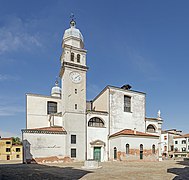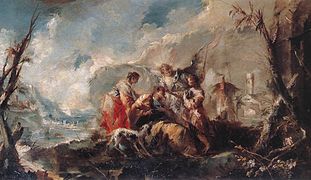
The Chiesa di San Pantaleone Martire, known as San Pantalon in the Venetian language, is a church in the Dorsoduro sestiere of Venice, Italy. It is located on the Campo San Pantalon (square), and is dedicated to Saint Pantaleon.

The Chiesa di San Giacomo dall'Orio is a church located in the sestiere (quarter) of Santa Croce in Venice, northern Italy.

Francesco Lazzaro Guardi was an Italian painter, nobleman, and a member of the Venetian School. He is considered to be among the last practitioners, along with his brothers, of the classic Venetian school of painting.

Ca' Rezzonico is a palazzo and art museum on the Grand Canal in the Dorsoduro sestiere of Venice, Italy. It is a particularly notable example of the 18th century Venetian baroque and rococo architecture and interior decoration, and displays paintings by the leading Venetian painters of the period, including Francesco Guardi and Giambattista Tiepolo. It is a public museum dedicated to 18th-century Venice and one of the 11 venues managed by the Fondazione Musei Civici di Venezia.
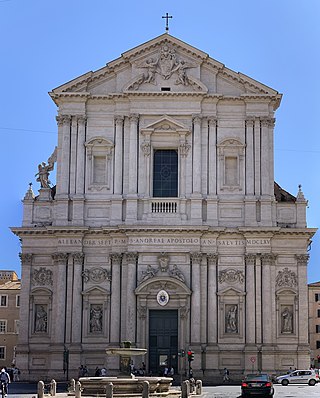
Sant'Andrea della Valle is a titular church and minor basilica in the rione of Sant'Eustachio of the city of Rome, Italy. The basilica is the seat of the general curia of the Theatines and is located on the Piazza Vidoni, at the intersection of Corso Vittorio Emanuele and Corso Rinascimento. It is one of the great 17th century preaching churches built by Counter-Reformation orders in the Centro Storico.

San Giorgio Maggiore is a 16th-century Benedictine church on the island of the same name in Venice, northern Italy, designed by Andrea Palladio, and built between 1566 and 1610. The church is a basilica in the classical Renaissance style and its brilliant white marble gleams above the blue water of the lagoon opposite the Piazzetta di San Marco and forms the focal point of the view from every part of the Riva degli Schiavoni.

San Francesco della Vigna is a Roman Catholic church in the Sestiere of Castello in Venice, northern Italy.
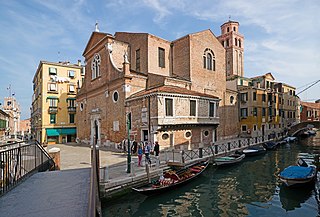
San Martino is a Renaissance Roman Catholic church in the sestiere of Castello of Venice, northern Italy.

Santa Maria dei Carmini, also called Santa Maria del Carmelo and commonly known simply as the Carmini, is a large Roman Catholic church in the sestiere, or neighbourhood, of Dorsoduro in Venice, northern Italy. It nestles against the former Scuola Grande di Santa Maria del Carmelo, also known as the Scuola dei Carmini. This charitable confraternity was officially founded in 1597, and arose from a lay women's charitable association, the Pinzocchere dei Carmini. The members of this lay group were associated as tertiaries to the neighbouring Carmelite monastery. They were responsible for stitching the scapulars for the Carmelites.
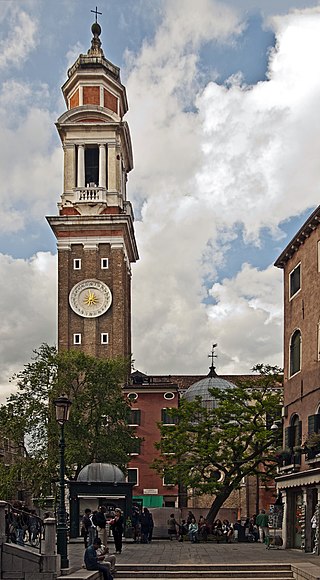
The Chiesa dei Santi Apostoli di Cristo, commonly called San Apostoli, is a 7th-century Roman Catholic church located in the Cannaregio sestiere of the Italian city of Venice. It is one of the oldest churches in the city and has undergone numerous changes since its foundation. The present building is the result of a major reconstruction project which was undertaken in 1575. The church is notable particularly for the Cornaro Chapel, an important example of Early Renaissance architecture, added by Mauro Codussi during the 1490s. The chapel is the burial place of several members of the powerful Cornaro family, including Catherine Cornaro, Queen of Cyprus and Armenia. The church houses several works of art including pieces by Giambattista Tiepolo and Paolo Veronese.

The church of Santa Maria Assunta, known as I Gesuiti, is a religious building in Venice, Italy. It is located in the sestiere of Cannaregio, in Campo dei Gesuiti, not far from the Fondamenta Nuove.
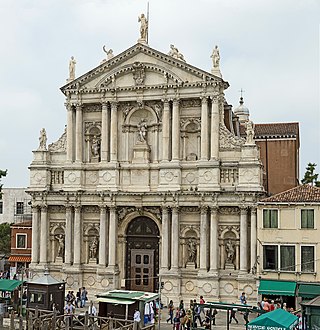
Santa Maria di Nazareth is a Roman Catholic Carmelite church in Venice, northern Italy. It is also called Church of the Scalzi being the seat in the city of the Discalced Carmelites religious order. Located in the sestiere of Cannaregio, near Venezia Santa Lucia railway station, it was built in the mid-17th century to the designs of Baldassarre Longhena and completed in the last decades of that century.

San Lino is a Renaissance-style, Roman Catholic church and former monastery in Volterra, region of Tuscany, Italy. It is located on Via San Lino in the historic center of the town.

Volterra Cathedral is a Roman Catholic cathedral in Volterra, Italy, dedicated to the Assumption of the Virgin Mary. It is the seat of the bishop of Volterra.

San Vidal is a former church, and now an event and concert hall located at one end of the Campo Santo Stefano in the Sestiere of San Marco, where it leads into the campiello San Vidal, and from there to the Ponte dell'Accademia that spans the Grand Canal and connects to the Sestiere of Dorsoduro, Venice, Italy.
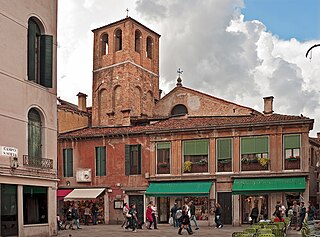
Santa Sofia is a church located in the sestiere (neighborhood) of Cannaregio in Venice, Italy. It should be distinguished from the palazzo Ca' d'Oro on the Grand Canal is also called the Palazzo Santa Sofia.
Michelangelo Morlaiter was an Italian painter, active mainly in Venice. He was one of the founding members and professor of the Accademia di Scoltura, Pittura, ed Architettura Civile in Venice in 1766.
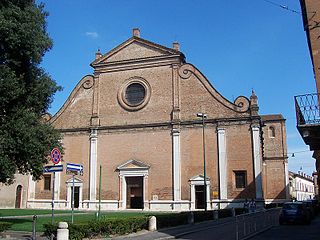
San Francesco is a late-Renaissance, Roman Catholic minor basilica church located on via Terranuova in Ferrara, Emilia-Romagna, Italy.

The Co-Cathedral of Saint Mary of the Assumption and Saint Catellus is the Roman Catholic duomo or cathedral of Castellammare di Stabia in the metropolitan city of Naples, in the region of Campania, Italy. It is the main church in Castellammare di Stabia and it is co-cathedral of the Archdiocese of Sorrento-Castellammare. It was built in 1587 and was consecrated in 1893. Inside on display for worship is the statue of Saint Catello, the patron saint of the city.
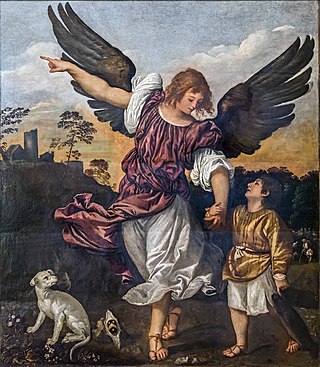
The Archangel Raphael and Tobias is an oil painting by Titian of Tobias and the Angel, dated to about 1512 to 1514, which is now in the Gallerie dell'Accademia in Venice. Another painting by Titian of the same subject, entitled Tobias and the Angel, dated to about 1540 to 1545, remains in the church of the Madonna dell'Orto in Venice.




